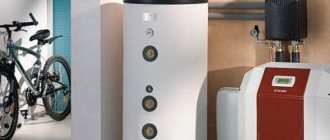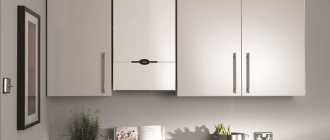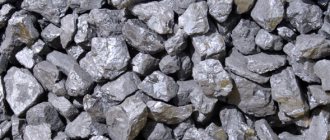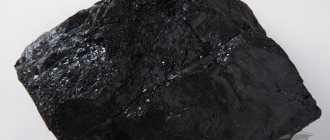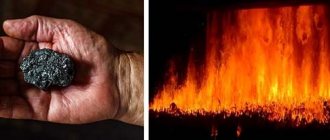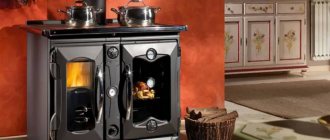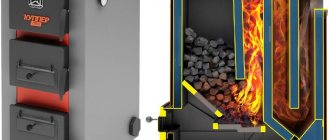To find out which coal is best to heat a solid fuel boiler in the house, you need to find the relevant information in its operating instructions. If there is no document, then it is recommended to go by trial: use different fractions and grades of coal. Then, after comparing the results, choose an acceptable option.
Coal quality indicators
This type of fuel has many characteristics, the totality of which determines its grade and brand.
But for proper operation of the boiler, it is enough to know the basics:
Caloric content (heat of combustion). This property shows the amount of energy released when a unit of fuel is burned - measured in kcal/kg. Coking coals provide the highest heat output - up to 8700. Anthracites are close to them in calorie content - up to 8600. Household solid fuel boilers are often not designed to use coking coals in them: the grate design may suffer (melt) due to high temperatures.
- Ash content. This indicator is important in determining the quality of coal. This type of fuel contains non-combustible substances: they remain in the form of ash residue after combustion. High-quality coal is characterized by a low % of the component with a greater release of heat. With an increased amount of ash, less heat is released - such coal is considered second-class. Good component indicator - < 25% of the fuel mass; low – 40% or more. The level of ash content also affects the frequency of cleaning the boiler (or furnace) and chimney pipes.
- Humidity. With a lower percentage, more heat is generated. There are two types of humidity: surface and internal. The first is removed by drying the coal in air, and the second is removed only by combustion in a furnace. In this case, a large amount of energy is spent on side drying processes. In this situation, the quality of heating and heating deteriorates. The range of 3-15% is considered the norm for the water content in coal. The first sign of increased moisture in fuel is its freezing during the cold season or sticking together in other seasons.
Homemade potbelly stove
Recently, many designers have been offering exclusive versions of potbelly stoves or fireplace stoves that are installed in country houses. For residents of prestigious cottages, they are not only an additional source of heat, but also a beautiful accessory for the interior design of the room. Such individual stoves fill the room with warmth and special comfort. Firewood crackling in a stove or fireplace looks very beautiful and romantic when a winter blizzard is raging outside the window.
The most popular, primitive and effective long-burning stove for temporary heating is the well-known potbelly stove. Its simple design is based on the “symbiosis” of a Russian stove and fireplace. With one load of fuel, it is capable of maintaining a comfortable indoor temperature for 4 hours. The potbelly stove can be installed in any space where a chimney can be removed.
Today, anyone who has the skills to perform plumbing work can make a potbelly stove with their own hands from all kinds of available materials. This oven:
- Does not depend on electricity or gas.
- Easy to maintain and operate.
- Allows you to control the combustion process.
- Takes up little space.
- Compact and economical.
- May have a hole for installing utensils to cook food or heat water.
Among the disadvantages of such a furnace, it should be noted the low efficiency, high speed of exhaust gases and rapid cooling. Therefore, to maintain the temperature in the room, it must be heated constantly.
The following can be used as fuel for a potbelly stove:
Materials and equipment for independent work
Our craftsmen make potbelly stoves with a welding machine on hand and used:
- large cans;
- metal corners;
- wide pipes;
- gas cylinders;
- metal boxes;
- large fire extinguishers;
- old barrels;
- steel sheets;
- chimney pipes;
- metal gratings.
For ease of work, you can also use factory-produced technical fittings in the form of:
Main elements of the combustion unit
Detailed drawings are not needed to make a potbelly stove. The main thing is to get the most efficient design possible. Let's look at the main components that make up a homemade stove.
Combustion chamber
It is the combustion chamber that performs the function of heat transfer. The larger the outer surface area, the better.
It is important that the bottom of the chamber has sufficient area to place firewood or coal there. Therefore, cylindrical homemade devices are placed on their sides
Rectangular ovens are designed in a horizontal design with a minimum size of 250x350 mm.
Large stoves made from barrels or gas cylinders are also practical in a vertical position.
Type of finished product
An additional ash pan welded or screwed to the bottom of the structure is convenient for selecting ash. Its arrangement with a blower promotes better heat generation, and the lower door ensures the supply of the required amount of oxygen and regulation of combustion intensity.
Doors and openings
These elements are made with your own hands from the leftover metal after cutting out the openings. After all, the scraps from the cylinders repeat the bend of the surface, and this is very important in work. Steel door canopies are attached to the body by welding, and then the doors themselves are hung on them.
Here it is necessary to provide a locking device, which can be made like a guillotine bolt or bolt.
The optimal openings for the firebox have dimensions of 250x250 mm, for the blower - a height of 100 and a width of 250 mm. Canopies are installed on one vertical axis. A distance of approximately 10 centimeters is maintained between the openings. To prevent coals from falling out of the door, the firebox opening is located slightly above the level of the grate.
To remove flue gases in a potbelly stove, a steel pipe with a diameter of 100–150 mm is used. The pipe itself is not insulated - it serves as an additional source of heat. And for better heat transfer, it is placed towards the outlet with inclined or horizontal sections, thereby increasing the path of warm gases.
The outlet pipe for connecting the chimney is located on top or, preferably, on the side. The latter option slows down the removal of gases, leaving space for the cooking zone.
Note! In the chimney, to regulate the intensity of removal of hot gases, it is advisable to use a rotary or guide valve
Methods for calculating the amount of coal for the winter
Most owners of private houses prefer to make preparations for the entire heating season.
In the European part of Russia it lasts from September to April. Depending on climatic conditions, different amounts of coal are consumed in different months.
Other factors affecting solid fuel consumption:
- boiler brand and design;
- type of heating;
- type of coal;
- technical characteristics of the structure, etc.
3 common methods of calculating coal consumption used by owners of private houses:
- Practical. It is used if there is no technical documentation for the boiler and it is necessary to experimentally determine the coal consumption for a conditional period. To do this, it is recommended to buy 100-150 kg (several bags) of fuel and see how much it is spent to maintain a comfortable temperature in the house in 1 day during the week. Based on the result obtained, you can calculate the consumption for a month or the entire season.
- Exemplary. It consists in knowing the average, experimentally established rate of coal consumption in the European part of Russia. For example, to heat a house with an area of 100 m² you need: in September and April 1 bucket (8 kg); December, January, February – 3-4; in March and October – 1-1.5. By multiplying the norm by the number of days in each month and summing up the results, you can get the amount of coal for the entire heating period.
- According to boiler power. It is based on a standard formula - to heat 10 m² of area you need to use 1 kW. In practice, this figure is achieved in severe frosts. At average seasonal temperatures, less fuel is consumed. For example, a house with an area of 150 m² needs a 15 kW boiler. To maintain a comfortable temperature during the day, you need to spend 15 x 24 = 360 kW of energy. 1 kg of coal gives 7.5 kW. To heat a house you need (per day) 360 / 7.5 = 48 kg. By making an adjustment for the device's rated efficiency, you can get a more accurate result.
In April and September, the estimated coal fuel consumption decreases by 50-75% from the peak winter months; in March, October by - 30-50%.
Heating engineers call the latter method of calculation conditional and capable of giving an error of up to 15-20%.
Electrical installations
In recent years, with the development of solar energy, when it became possible to receive free electricity, heating a home using various electric convectors and infrared heaters has gained popularity in the domestic market.
Such devices are reliable, quickly heat the room, and there is no need to lay a pipe system throughout the house; the homeowner will be spared the need to install heating radiators. The advantages of electric heating include the following:
- ease of maintenance;
- an electric boiler can also be used to heat water;
- reduction of costs for installation and purchase of necessary equipment;
- environmental Safety;
- efficiency and full automation of the heating system.
Electric heating systems usually include underfloor heating, which is often installed in the kitchen, bathroom and toilet. Today, there are various technologies for arranging a heated floor system, which are efficient and allow you to quickly heat rooms while consuming a minimum of electricity.
The only downside to this technology for heating a private home is the significant consumption of electricity, which leads to a significant increase in utility costs. There may also be problems with heat in the house during power outages, which can occur in remote villages, dachas and farmsteads.
Features of fuel storage
To provide a residential building with coal for the autumn-winter-spring period, owners must provide conditions for its storage. With their proper organization, the operation of solid fuel equipment will become safe and the maximum efficiency of the unit will be achieved.
The main storage conditions:
- ease of access to fuel for transporting it to the stove;
- the presence of a special storage room near the house and maintaining comfortable conditions in it;
- good lighting and sufficient ventilation for loading and unloading operations, etc.
When the warehouse is fully loaded with fuel for the entire cold period, the main condition for its storage must be met - it must not lose its functional (combustible) properties. The main weakness of coal after mining and raising it to the surface is oxidation. The larger the pieces, the longer they will retain their properties. For example, coal with a fraction of more than 100 mm can be stored (without loss of quality) for up to 3 years, and fine coal - less than 1 year. The latter is recommended to be purchased only for 1 season.
Requirements for place and storage conditions:
- It is advisable to package the fuel in bags or wooden boxes;
- the room (except during loading and unloading) should be dark;
- if coal is poured into a special pit, it must be compacted to reduce the air gap;
- if fuel is stored in the yard, it is advisable to cover it with a lid or thick plastic wrap;
- the warehouse space must be voluminous: annual coal demand (for 100 m² of area - 4 m³ of fuel) + passage + 5% reserve;
- the warehouse must be equipped with drainage systems for the removal of groundwater, melt water, and rainwater.
Prohibitions to the location of the storage room:
- it cannot be equipped with communications: electrical lines, gas pipelines, heating plants;
- it should not be located above underground pipelines, gas pipelines, electrical cables, etc.
Owners need to remember: if storage conditions are violated, coal can ignite.
Therefore, small pieces must be well compacted, without leaving air gaps, to avoid spontaneous combustion.
Preparatory stage of lighting the stove
If you are planning to light a stove that has not been used for a long time, you should carry out a number of preparatory measures.
This procedure must be carried out in order to ensure trouble-free operation of the stove, as well as to avoid unpleasant situations that sometimes lead to fires or harm to human health and life. • Inspect for cracks. Their presence can facilitate the penetration of smoke and even carbon monoxide into the room. If any are found, minor repairs should be immediately carried out using a mixture of clay and sand. • Clean soot from all flues and chimneys. Wipe off dust from the internal walls with a dry rag so as not to smell a bad aroma when kindling. In general, it is advisable to perform this procedure 2-3 times a month.
• Pay attention to the doors, especially their fit and the functionality of the locking mechanisms, to avoid the appearance of smoke. • Select fuel of the appropriate quality, suitable specifically for your type of stove
• Properly equip solid fuel storage areas.
During further operation, you should also follow a number of simple rules. Using plastic, construction and household waste for kindling will lead to severe contamination of the stove. It is incorrect to open the vent and the oven door at the same time. It should be heated several times a day for one and a half to two hours to avoid overheating. Dry, medium-sized, dust-free charcoal will provide excellent functionality.
Avoid storing flammable objects near hot walls. Do not leave the stove unattended while lighting, especially in homes with children.
Popular brands of solid fuel
For many centuries, people have been using various types of it for specified purposes (smelting metals, firing ceramics, etc.). But not all brands of coal are used for heating, but those suitable for their specific properties.
Table 1. Popular fuel brands and their features
| № | Name | Advantages | Flaws |
| 1 | Long flame (D) | Easy to ignite; generate quite a lot of heat; have a low cost; burn for a long time | Large emissions of furnace gas and smoke |
| 2 | Long-flame gas (LG) | ||
| 3 | Anthracite (A) | Contains a high percentage of carbon; burns almost without smoke; little ash and slag remains | Prolonged combustion; high price |
| 4 | Low Caking (SS) | In terms of quality characteristics they are inferior to other types, but have a low cost | |
| 5 | Skinny (T) | ||
Popular fractions of coal for heating a private home include:
- O (walnut) – from 25 to 50 mm;
- K (large) – from 50 to 100 mm;
- C (seeds) – from 6 to 13 mm;
- M (small) – from 13 to 25 mm.
Advantages of heating a house with coal
Brown coal
Coal boilers for home heating have many advantages:
- Coal is mined on Russian territory, and prices do not fluctuate.
- To use this fuel, you do not need to install special gas pipelines, as for gas heating.
- Its price is relatively low compared to liquid fuel or gas.
- Easy to transport, it does not require special storage conditions.
- Heating with coal is beneficial because it retains heat during smoldering. Thus, the heated air in the room will remain warm for a long time.
- The good thermal output of coal makes it possible to use it in small batches in order to maintain a comfortable temperature even in severe frosts.
Criterias of choice
The main one is the boiler model. If the manufacturer has technically provided for the use of 1-2 grades of coal for normal operation, then the question of choice disappears: it is necessary to use only the types of fuel specified in the operating instructions.
In other cases, heating engineers consider anthracite to be the best option. Although there are many nuances when it is more profitable to use less expensive brands. Another determining criterion for selection is the size of the fraction: fine ignites and burns faster than large ones, but more often requires a new filling.
According to this criterion, preference is given to “nuts” (50 mm) and large ones (up to 80 mm). Such coal will burn longer and produce more heat.
Is coal right for you?
To answer this question, let's look at two important points:
- Boiler type
- Coal fraction
Let's take a closer look at each of them.
Boiler type
Solid fuel boilers can operate on any solid combustible material. Therefore, formally we can say this: coal will suit you in any case. The only question is whether it will be effective.
It is important to understand that each boiler is designed for a specific fuel. For example, wood-burning boilers burn wood; pellet - on compressed granules. And so on. In the passport, each manufacturer indicates the preferred type of fuel. If firewood is indicated there, this does not mean that coal cannot be thrown. But the effect will be much lower.
If your boiler specifies coal as the main fuel, then you can expect high efficiency when using it.
If you plan to heat your house with coal, then you need to purchase a coal boiler.
Coal fraction
This is another important indicator, and it is also related to the possibility of using coal in the boiler.
The fact is that the fuel supply in household boilers is carried out through a rather small hatch. It is not always possible to place material with large pieces in it. After mining, coal is sieved and divided into fractions by size. Some of the material is supplied in the form in which it was mined. This is the 0-300 fraction, or the so-called raw coal. It contains both large pieces (up to 300 mm) and dust.
We have the following varieties on sale:
- 20-40 mm – small long-stone nut (HOUSE)
- 50-200 mm – long-flame slab (WPC)
- 0-300 mm – regular long-flame (DR)
For all home boilers from this list, only one fraction is suitable - 20-40 mm. It contains small grains that are easily loaded into the firebox and burn evenly.
Fractions 50-200 and 0-300 are cheaper, but are not suitable for home heating. They can contain both small and large grains. Such coal will burn unevenly, and unburned pieces will remain. If you have an automatic boiler, then large grains will simply clog the feeder, and as a result, coal will stop flowing into the firebox altogether.
Let's summarize:
For household coal boilers, you should purchase coal of a fraction of 20-40 mm.
How to properly heat a solid fuel boiler
The process of operating the device consists of the following stages:
- Pre-ignition. On the grate you need to make a small fire from paper and wood chips. You can use other materials: branches, birch bark, sawdust. Place large logs on top and set fire. To ensure air circulation, do not place the components of the fire too tightly together.
- Primary bookmark. It is made on the coals of a fire, in a small portion, about 1-2 handfuls from both hands. The smaller the fuel fraction, the faster the combustion will occur. Then you need to periodically stir the pieces of coal for high-quality ignition.
- When the first batch of fuel flares up, you can add the next one. Now you can take larger pieces.
Next, you need to monitor the boiler and add fuel as necessary. According to the instructions, it is clear that in addition to coal, other materials are involved in the process of igniting the unit. Therefore, owners need to stock up on firewood and wood chips based on seasonal needs. It is better to store them under a canopy or in another room to keep them dry.
Firewood
Firewood is another popular type of fuel for boilers. Only dried wood is suitable for burning. Under-dried firewood in the firebox begins to release moisture, which accumulates on the internal surfaces of the firebox and chimney. In combination with smoke and carbon monoxide, tar is formed - it reduces the operational properties of the boiler and reduces the permeability of exhaust gases.
Firewood selection
For melting, hardwood with a long burning life and slow heat transfer is optimal. Preference should be given to deciduous trees over coniferous ones. During the combustion process, conifers emit a large amount of resinous substances and quickly pollute the combustion chamber and heat exchanger.
According to the degree of hardness, wood species are divided into 3 categories:
- hard - white acacia, ash, beech, oak, maple, yew, hazel, pear;
- medium hard - walnut, alder, sycamore, birch, cherry, cherry, cedar;
- soft - poplar, aspen.
How to heat a boiler with wood
- At the first stage, it is necessary to warm up the heating device well. This will prevent smoke from leaking into the room. Sheets of paper are placed at the bottom of the fuel chamber, on them are flammable birch bark, chips and splinters, and on top are small logs (up to 15 cm in diameter). The space between the chips can be filled with paper for faster ignition.
- When the firebox is about half full, you should set fire to the paper and open the ash pan valve for better draft. Close the main chamber door.
- When the chamber and chimney warm up and the preparatory filling begins to burn out, the firebox can be filled with large firewood. You can lay out the logs in a row or in the form of a well, leaving gaps between them for air penetration.
- As the firewood burns out, you will need to make a new stack without waiting for the previous one to die out.
Long-burning boilers greatly simplify the work. Fuel is added to them once every 6 hours due to automatic regulation of draft and combustion process. Such devices should be melted in accordance with the attached instructions.
What to do if the fuel burns poorly
On Internet forums, people who use a stove or boiler to heat a room raise this issue. The answers of heating engineers can be combined into 4 groups based on several characteristic signs of poor-quality equipment operation.
Table 2. Solutions to the problem of poor combustion quality
| № | The reason for the deterioration of combustion | Elimination method |
| 1 | Clogged chimney and ducts | Thorough cleaning of the entire structure |
| 2 | Using old coal. It is noted that already in the second year of storage the fuel burns worse | Purchase of fresh coal (current year of production) |
| 3 | Wear of the furnace device, burnout of the grate | Repair and replacement of worn components |
| 4 | Increased moisture content of coal | Air drying in dry and windy weather |
Causes of smoke
Sometimes, even when the stove is properly lit, smoke may form. The reason may be poor quality coal. But most often the following factors influence smoke:
- the appearance of cracks in brickwork;
- presence of blockages in the chimney and stove channels;
- destruction of the internal part of the heating device.
The appearance of smoke may be due to blockages in the chimney and stove channels.
When igniting in a very cool firebox, smoke may also be released in the entire stove system. Soot often forms when two stoves are directly connected to one chimney. To avoid smoke, a smoke damper is installed.
Prices: summary table
Price rating of popular models of coal-fired boilers:
| Coal boiler model | Cost, rub. |
| ZOTA "Master" 20 | 34 000 |
| Protherm “Beaver” 20 DLO | 79 000 |
| Bosch "Solid" 2000 B SFU 12 | 80 000 |
| Stropuva S15U | 81 500–99 778 |
| Buderus "Logano" S181-15 E | 252 000–258 840 |
| LIEPSNELE L20U | 110 000 |
| Galmet "CARBO" 21 | 113 890–116 759 |
| ZOTA "Carbon" 20 | 47 900–53 290 |
| Teplodar "Kupper" OVK 10 | 23 050–25 680 |
| Thermocraft "Uragan" Prof 22 | 28 640–34 641 |
Poll: For what reason did you prefer a coal boiler?
Characteristics of groups
https://youtube.com/watch?v=vHmPxPKH744
The second most popular type of coal can be considered grade T. It is called “lean”, is characterized by the release of volatile substances in the range of 9-17%, does not sinter, and practically does not emit a flame when burning. It contains about 90% carbon, so this coal is considered the richest. It is indispensable in the fuel industry, chemical production, gas generating plants, housing and communal services and mobile power plants.
So, brand D is the most popular
The third group is long-flame gas DG coal, low-caking, with low fragility and high strength. Unsuitable for coke batches because the resulting coke is radioactive. The yield of volatile substances is in the range of 27-30%, refers to energy rocks.

